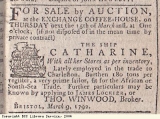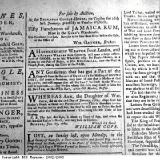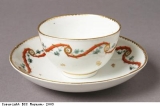Trade goods from the East: Tea
When the Europeans first began trading with China, the main item they were interested in was silk. But the trade developed and soon tea became the main product that they purchased for import . This was a new, expensive but healthy drink in Europe. At first, in the 1650s, the amount imported was small, perhaps 1 cwt (50 kgs) per ship. Eventually the demand for tea at home grew, and the amount brought into the country increased. In 1713 the East India Company imported 214,000 lbs of tea (97,000 kgs). By 1813 this had risen to 32,000,000 lbs (14,500,000kgs). The tax paid on tea was a large part of the government’s income. Until the late 19th century, all tea drunk in Britain was from China. After that time, India and Sri Lanka started trading tea.
The growth in tea drinking led to an increase in the demand for Chinese porcelain. The fine porcelain made in China had long been admired in the west, but it had not been a major trade item for the East India Company. Porcelain tea and dinner services, however, made an excellent ballast to balance the bulky but lightweight cargo of tea. The porcelain was heavy and could be stacked around and under the tea chests, to keep them clear of the water in the bilges of the ships.
Tea started as an exotic fashion for those who could afford it. By the late 18th century it was drunk by everyone, sweetened with cheap sugar from the Caribbean. Ladies drank their tea from delicate porcelain tea bowls and cups, either imported from China with the tea or copied by local potteries in Britain.
Coffee was also imported by the East India Company. Coffee was grown in East Africa. It was bought in the country of Yemen, at first to sell in the Middle East, and then to bring back to London. Coffee drinking became fashionable. The first coffee house in London was opened in 1657, the first mention of one in Bristol comes in 1677. The coffee houses were where businessmen met. They were also places for discussing politics and socialising. Coffee houses were also used as sale rooms. For example, fifty barrels of rum from Jamaica in the Caribbean were sold at the Exchange Coffee-house in Bristol on 16 January 1762. On another occasion at the Exchange Coffee-house, the ship Catharine was sold by auction on 15 March 1792. The ship was advertised as ‘fit for the African or South-Sea Trade’.





